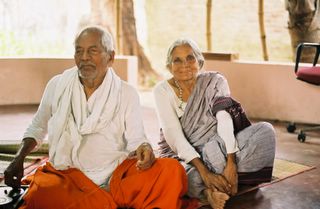I am Tourist

For the first and last time on this trip, I became a tourist. I’m frankly not very good at it anywhere anymore, and especially not in India, where I have seen everything I really want to see in the tourist way of things multiple times, and am more interested in the descendants of the people who built the great temples (or, especially, those who were never even allowed to go near the great temples) than I am in the temples themselves.
Nonetheless, with an afternoon to kill, off I went with my friend and driver Muttukumar to the shore town of Mahabalipuram, home to the great sculptures, the world’s largest bas relief, and shore temple created by the Pallava Dynasty in the 7th and 8th Centuries. It was a relatively uneventful 27 km. drive from Chengelput, past fields being subdivided for housing complexes with outrageous prices, goats, pigs, water buffalo, and cows occasionally clogging up the highway.

We get to the complex and pay the 250 rupee entrance fee for me as a foreign tourist and 10 rupees for Muttukumar as a resident Indian. Then we exchange tickets, which confuses the security people (they don’t seem to be amused). We climb to the great cave, and take the obligatory photograph of me underneath and holding up “Krishna’s Butter Ball” (a huge boulder about 20’ feet across and 16’ high), and then milking the stone cow. We walk to the shore temple, of most interest to me because it was overtopped by the tsunami wave, yet remained wholly undamaged. Now, the Indian Government has built a large retaining wall in front, together with a larger sand barrier. The shore hotels just to the north seem all to have been rebuilt and are doing a booming business. In town, there are the day tourists, both Indian and western, and the longer-term ones, some obviously strung out.
The local industry is stone carving. Some of the carvings are huge, such as a 9’ long recumbent Shiva in gray stone. Some of the work is pretty stiff, meant for the trinket market. Some of the pieces are really remarkable. On the way back, I purchase a present for Ellen my wife. More stuff to have around the house. Actually, it is quite intriguing, in a humorous sort of way. A semi-recumbent Ganesh – Vinayaka – bringer of boons, remover of obstacles, Lord of new beginnings, and second chances – carved in a reddish marble, seated on what could be a recliner, an Apple laptop on his lap. Whether it more resembles Ellen or myself will have to remain open to interpretation.
We drive back. I notice a political sign of a variety I’ve never seen before. It features Dr. Ambedkar, the great Dalit statesman, and Che Guevara in the corner, with the faces of others standing for election. It seems there is now a Dalit political party, which, in certain areas, could prove a majority if they organized themselves well. I think this a remarkable development.
The sides of the roads, and the area around some of the monuments are filthy, covered in refuse. Anyone from the West who visits India gets a first impression that Indians must be a filthy people, as they throw garbage and refuse any which way without a second thought. A longer look will reveal that Indians make different distinctions between private and public spheres and spaces than most westerners, and are actually quite fastidious about personal and household cleanliness (though try staying clean in a mudhut!) But closer examination reveals something further. Rural India and Indians (some 70% of the population, and most of the people in cities have only relatively recently arrived) have been invaded by indestructible packaging that they didn’t ask for: plastic bags, plastic bottles, Styrofoam, aluminum, cans (which are often put to secondary and tertiary uses), etc. None of this was their choice.
If you look more carefully, whether it be by the side of the road, or outside stores and tea shops, or by the sides of homes, even the mudhuts, there are signs of constant rubbish fires as Indians try to dispose of the flotsam and jetsam that have been inflicted upon them. All to no avail of course; the mountains of trash grow ever greater. There is no municipal trash pickup; the only substitutes are the goats, and even they have their limits.
We return back to Sathya’s house. There are the eight children from Nagaraj’s settlement sitting on the porch, all in their school uniforms, watching as Velmuruga tries to teach them to read, “Tongue and teeth are in my mouth.” I interrupt, and treat them to a rousing version of “Head and shoulders, knees and toes.” Somehow I get tongue and teeth, elbow and belly in there too, and I think this is likely the high point of the kids’ day. Or perhaps not – but it is the high point of mine. There are no lights in the stone; there are lamps in the kids.
Veerasami has arrived from Kuthur. Took him eight hours. I have Sathya translate for me the mission I have for us tomorrow.
We will get back to the important work of begging.


1 Comments:
Rajasthan tour packages India Find exotic Rajasthan tour packages India at AGISE Tours and Travels. Explore the exotic destinations of this astonishing state at amazingly low price
Post a Comment
<< Home